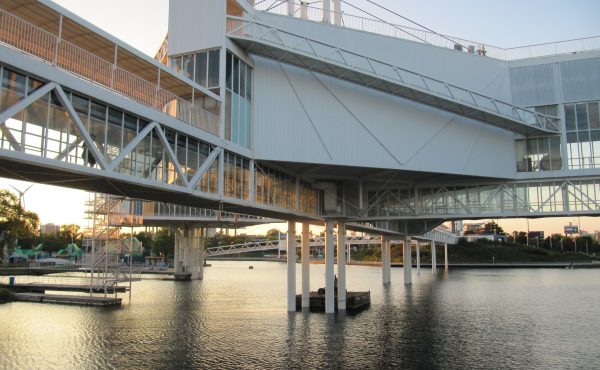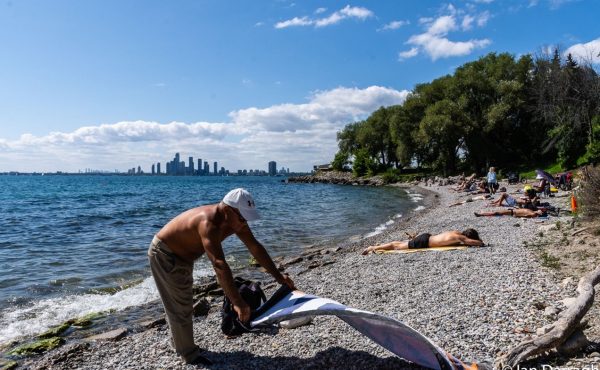New York’s Projects for Public Spaces (PPS) recently dedicated their website to discussing what they call “The Waterfront Renaissance.” It’s a great read, and there are more than a few articles that got me thinking about the process of waterfront revitalization in Toronto.
Over the past hundred years, shipping and industry have dispersed from riverfronts, seafronts, and lakefronts, making cities around the world rethink what to do in these prime locations–the birthplace, in most cases, of the city itself. As humans we are naturally drawn to explore the water’s edge, which makes it deeply disappointing when all we find there is a highway, fenced-off industrial facilities or, just as bad, a mediocre shopping mall or underused park.
Creating a vibrant waterfront means making it part of a larger network of community places. This involves more than making the waterfront physically accessible; it requires a community-driven process, a good design, and an ongoing management program.
What I found most interesting was an article entitled How To Turn a Waterfront Around, which describes thirteen ideas the organization considers crucial to waterfront redevelopment. In some instances it seems Toronto is on the right track, but in others it looks like our current trajectory is ignoring some important ideas. One example is the goal of “creating multiple destinations” on the waterfront:
PPS has found that an effective way to structure a vision process is to set a goal of creating ten great destinations along the entire waterfront, an idea we call the “Power of Ten.” This focus on destinations, rather than “open space” or parks, enables a genuine community-led process to take root. Once ten destinations have been identified, then nearby residents, businesses, community organizations and other stakeholders begin to define the uses and activities they want to see at each place. Ideally, each destination should provide ten things to do, which creates diverse, layered activity, ensuring that no single use will predominate.
This process is open-ended–so that the result can fulfill the hopes of people involved in the process. This cannot happen when it is assumed from the outset that the goal is to build, say, a park, which may narrow the range of possible outcomes and prevent some of the best ideas from ever seeing the light of day.
If you take the City of Toronto’s virtual waterfront tour, you’ll find most of the destinations are parks and gardens, and a look at the Toronto Waterfront Revitalization Corporation’s current projects shows that almost all developments are park and community building ones. I don’t think this is necessarily a bad thing, but it makes you wonder if the current vision for the waterfront is accurately addressing its public space needs.
Off the top of my head, we already have Harbourfront Centre, Ontario Place, the CNE, and maybe Fort York; add to that the shrouded-in-secrecy “Project Symphony” and we’re still only half way there. The number ten is obviously not a set-in-stone rule, but for a city of Toronto’s size it doesn’t seem completely unrealistic.
West 8 included an iconic building at the foot of Jarvis in their design: it’s the bulbous, postmodern igloo that appears at the far right of the image below. The building was called the UNESCO University for Peace, but next-to-nothing has been said about it in the last 8 months, and it’s difficult to find any of the close-up renderings of the building that were part of their entry to the design competition. Whether this is because there’s no commitment from any level of government to help build it or because someone decided it wasn’t an important element of the design, it indicates this kind of redevelopment is less of a priority.

One last comment on this by PPS, which mentions Toronto directly:
[P]arks should not serve as the raison d’àªtre of the entire waterfront. Passive open space puts a damper on the inherent vibrancy of waterfronts, evident in cities such as New York, Vancouver, and Toronto that have relied too heavily on “greening” their waterfronts without mixing uses that draw people for different reasons at different times. The world’s best waterfronts use parks as connective tissue, using them to link major destinations together. Helsinki, Stockholm, Sydney, and Baltimore have employed this strategy to fine effect.
On the plus side, we’re no longer on the waterfront Hall of Shame, which has to be seen as a step in the right the direction. I’d be interested to know what Spacing readers think this, or anything else in The Waterfront Renaissance.
Top image from PPS, bottom by West 8.





2 comments
I believe the Toronto Waterfront folks have an official “parks first” strategy: people always demand parks, so they wanted to start with highly visible parks projects to build confidence that something was finally happening on the waterfront. It has weird effects — Commissioners Park in the Portlands may be built 10-15 years before there’s a neighbourhood nearby.
The full PPS list suggests limiting residential development, but to my mind that’s helped bring year-round activity to Queens Quay. I’ve been amazed this winter at how much busier it is down there than it used to be.
I’d add the music garden to the public spaces list — yes, it’s a park, but it’s also a small and unusual concert venue. West 8’s “harbour village” concept (a cluster of low-rise shops/restaurants west of Queens Quay Terminal) has the potential to create interesting small-scale street spaces.
As for the UNESCO building, I don’t think it was part of the official “phase 1” project — and isn’t that location within the East Bayfront precinct? Plus, I’d think you’d need to get the UN involved.
On the UNESCO University for Peace, it seems government support was lacking. See here for details.